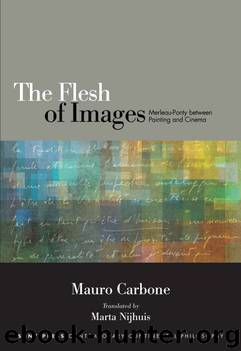The Flesh of Images by Mauro Carbone

Author:Mauro Carbone
Language: eng
Format: epub
Publisher: State University of New York Press
Published: 2015-07-24T16:00:00+00:00
Chapter Five
The Light of the Flesh
Anti-Platonistic Instances and Neoplatonic Traces in the Later Merleau-Ponty’s Thinking
I love today’s art because I love Light above all else
—Guillaume Apollinaire
“A New Idea of Light”
The analysis above led me to highlight that, in the reflections Merleau-Ponty consecrated to cinema, the programmatic attention toward appearing—after which phenomenology itself is named—conjugates and feeds with the overriding consideration of the whole, which makes the Gestalttheorie affirm the indecomposable feature of the perceived phenomena. On the one hand, this addresses such reflections toward a notion of perception as montage operating according to the peculiar logic binding our body to the world. On the other hand, this implies some increasingly profound critiques against metaphysics meant as a thinking that places, on the contrary, the true beyond appearing itself. Such critiques led Merleau-Ponty’s later thinking to try to no longer conceive the giving of the true by following the traditional opposition—built by Plato in the Allegory of the Cave—between the deceiving shadows of what appears and the pure light emanating from truth. The giving of the true shall rather be conceived on the basis of an essential complementarity between light and shade.
Among the constants crossing the last courses Merleau-Ponty gave at the Collège de France, one can indeed find the search for what he defines—in the preparatory notes for the course titled “Philosophy and Non-Philosophy since Hegel”—as “a new idea of light.” On this subject, he explains, “truth is of itself zweideutig […]. The Vieldeutigkeit is not a shadow to be eliminated from true light.”1
Evidently, this cannot but suggest an ontological rehabilitation of the surface on which appearing shows itself. Such a surface shall no longer be thought as a veil that would conceal the true and that shall hence be removed or even pierced. Rather, it shall be considered as a screen that reveals itself to be the decisive condition to make seen the images in which truth is manifested—just like in the case of the figure-ground relation or in the perception of the stroboscopic movement.2 Such a rehabilitation may thus be characterized as the progressive affirmation of a different way of conceiving the giving of the true, which, from a theatrical configuration—namely, a representative configuration par excellence, opening at the opening of the curtain—gets to a cinematic configuration.
In short: the ontological rehabilitation of the surface, which leads us to consider the screen as the condition of possibility of vision, is one and the same with “a new idea of light” as inseparable from shade, for it is indeed the ground of the screen that makes visible the truth of the shared mutual appearing of shade and light.
Among the authors Merleau-Ponty confronts on this issue in his last courses are not only Hegel and Nietzsche,3 but also Schelling (about whom I shall talk mainly by referring to the brilliant interpretation by an eminent Italian specialist of his reflection, that is, Francesco Moiso),4 Descartes (whom my analysis will not directly evoke), and Proust, on whom I shall focus first of all.
Download
This site does not store any files on its server. We only index and link to content provided by other sites. Please contact the content providers to delete copyright contents if any and email us, we'll remove relevant links or contents immediately.
| Deconstruction | Existentialism |
| Humanism | Phenomenology |
| Pragmatism | Rationalism |
| Structuralism | Transcendentalism |
| Utilitarianism |
The remains of the day by Kazuo Ishiguro(7551)
Tools of Titans by Timothy Ferriss(6949)
The Black Swan by Nassim Nicholas Taleb(6192)
Inner Engineering: A Yogi's Guide to Joy by Sadhguru(5897)
Giovanni's Room by James Baldwin(5879)
The Way of Zen by Alan W. Watts(5800)
The Six Wives Of Henry VIII (WOMEN IN HISTORY) by Fraser Antonia(4791)
The Power of Now: A Guide to Spiritual Enlightenment by Eckhart Tolle(4756)
Astrophysics for People in a Hurry by Neil DeGrasse Tyson(4620)
Asking the Right Questions: A Guide to Critical Thinking by M. Neil Browne & Stuart M. Keeley(4576)
12 Rules for Life by Jordan B. Peterson(3734)
The Ethical Slut by Janet W. Hardy(3504)
Skin in the Game by Nassim Nicholas Taleb(3462)
Housekeeping by Marilynne Robinson(3402)
The Art of Happiness by The Dalai Lama(3385)
Double Down (Diary of a Wimpy Kid Book 11) by Jeff Kinney(3274)
Skin in the Game: Hidden Asymmetries in Daily Life by Nassim Nicholas Taleb(3264)
Walking by Henry David Thoreau(3234)
12 Rules for Life: An Antidote to Chaos by Jordan B. Peterson(3204)
